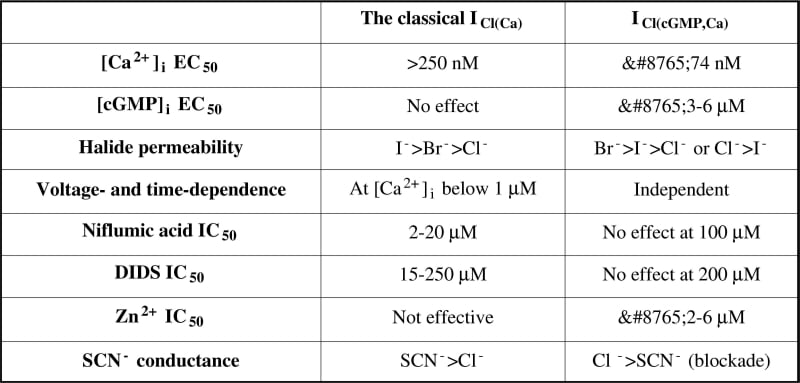We have recently described a unique cGMP-activated Ca2 -activated chloride current (ICl(cGMP, Ca)) in smooth muscle cells (SMCs) (Matchkov et al. 2004) with properties distinct from the classical Ca2 -activated chloride current (ICl(Ca)). In contrast to ICl(Ca), the new current is activated by cGMP via PKG. In the following table the properties of the classical ICl(Ca) and the novel ICl(cGMP, Ca) are compared. Interestingly, both currents were found to co-exist in smooth muscle cells, where they can be separated pharmacologically. We characterised the distribution of the ICl(cGMP, Ca) in vascular and non-vascular SMCs of different origin: aorta, pulmonary artery, tail artery, femoral artery, femoral vein, middle cerebral artery, renal artery, portal vein, superior mesenteric artery, mesenteric small artery and colon and compared distribution to that of classical ICl(Ca). The conventional patch-clamp technique was used. Rats were humanely killed, tissues were excised, and fresh SMCs were enzymatically isolated. We found that ICl(Ca) and ICl(cGMP,Ca) co-exist throughout the vascular tree, with the exception of the pulmonary circulation where only ICl(Ca) was found. ICl(cGMP, Ca) was dominant in cerebral artery and femoral vein, and was larger than ICl(Ca) in aorta, renal, femoral, mesenteric small and superior mesenteric arteries. ICl(Ca) was pronounced in portal vein and tail artery. ICl(cGMP, Ca) was also present in SMCs of colon (Matchkov et al. 2005). The present data point to the possibility that ICl(cGMP,Ca) may play a significant role in the regulation of vascular and potentially non-vascular smooth muscle. Selective inhibition of ICl(cGMP, Ca) inhibits vasomotion, demonstrating the essential role of this channel in synchronising cellular activity (Peng et al. 2001). This channel has all required properties to be a link between two major signalling pathways: calcium and NO/cGMP.
University of Oxford (2005) J Physiol 568P, PC1
Poster Communications: A cyclic GMP-dependent calcium-activated chloride channel in smooth muscle tissues: properties, distribution and identity
Matchkov, Vladimir; Briggs, Donna M.; Aalkjaer, Christian; Nilsson, Holger;
1. Water and Salt Research Centre, Institute of Physiology and Biophysics, University of Aarhus, Aarhus, Denmark.
View other abstracts by:
Table 1. Comparison of the properties of the classical ICl(Ca) and the novel ICl(cGMP Ca).
Where applicable, experiments conform with Society ethical requirements.

